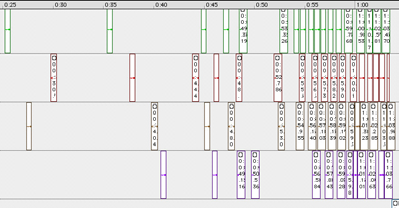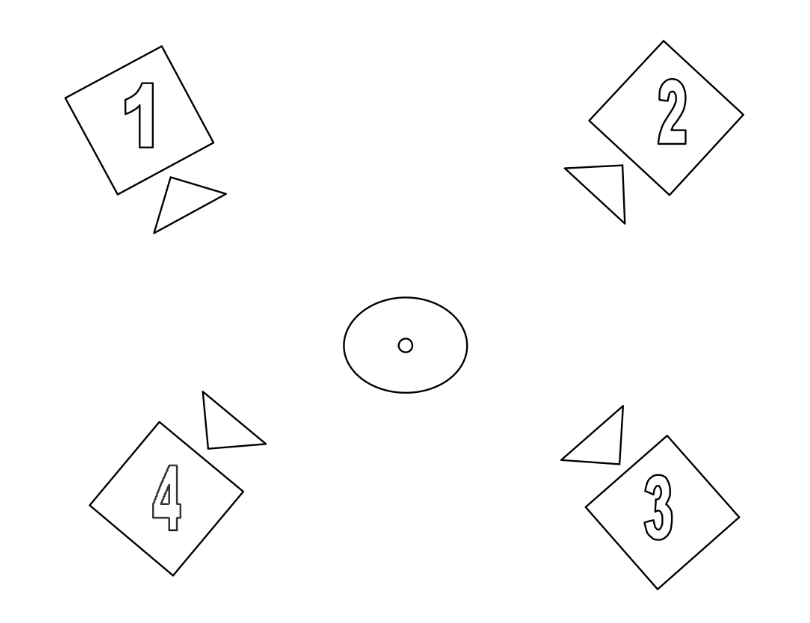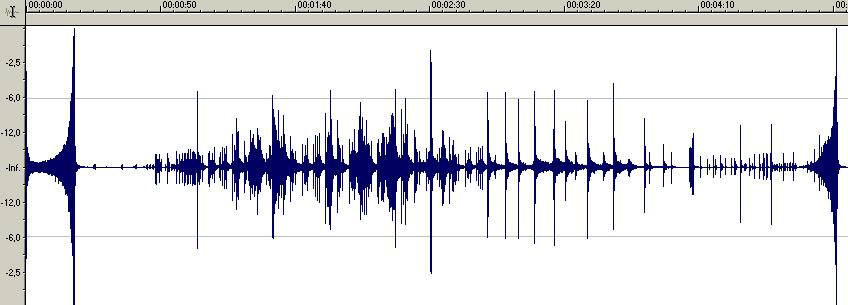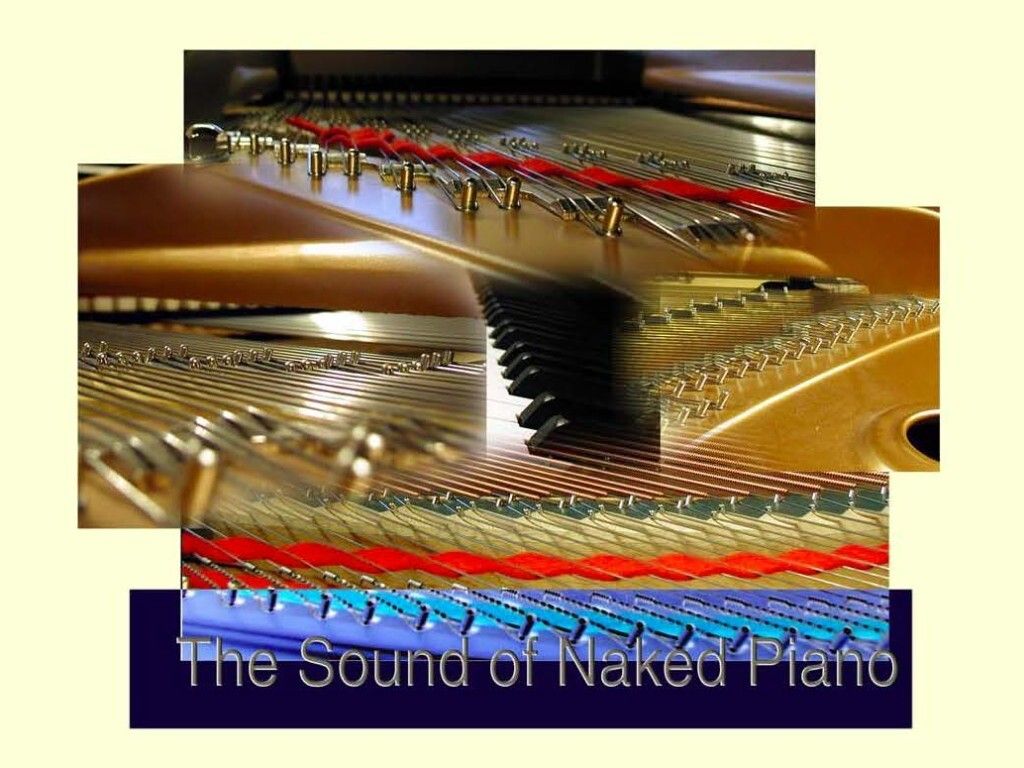Here is my latest electroacoustic composition “The Sound of Naked Piano”:
I got the idea to the title of this piece from a concert outside the San Francisco Museum of Modern art: ”The sound of naked Men”. A naked man was lying with contact microphones attached to his body. Lots of amplifiers and speakers provided the audience with crisp sounds of heart beats, and blood pulsating through the veins of the “performer”. Somehow I felt a close similarity when I was standing bent inside the grand piano with my microphone.
The idea of “The Sound of Naked Piano”, was to use various sounds from the piano, cut them to pieces, manipulate them and mix it all together in a 4 channel piece. In the end, this has turned out to a 5 minute session with various layers and a close to classical “rondo” structure.
Sound Recording And Manipulation
The sounds are from a Yamaha C3 grand piano in the Department of Musicology (ZEB). I used a Sony ECM-MS907 stereo microphone with a Roland UA-30 USB ADC device connected to my PC laptop. Due to the limitations of the equipment, all sounds were recorded in 16-bit and 44,1 kHz in Sound Forge 4.5.
- The tone C4
- Finger tapping on the note stand
- Hitting the instrument with flat hand
- Pedal down
- Sliding nail on string
- Sliding coin on string
- Falling coin on strings
Starting to manipulate the sounds, my intention was to tweak the sounds, but only to the extent that they could still be perceived as piano-like. I used the following programs for manipulation:
- Sound Forge 4.5 (Win)
- Cool Edit Pro 1.2 (Win)
- Peak (Mac)
- Pro Tools (Mac)
- CDP (Unix)
I applied lots of different effects; time stretch, time bend, ring-modulation, harmonizing, chorus, reverb and granulation. Some of the resulting sounds will be commented later on.
Mixing
I thought this project could be a good chance to learn Pro Tools and multichannel sequencing. As this was my first attempt on doing anything like this, I thought it would be wize to start gently with 4 channels and see what I could get out of this. When I finally managed to get the DAC, speakers and computer to cooperate, the setup was a dream to work with.

After some testing, I found that I wanted to concentrate on working with two stereo-pairs, front and back. This gives this speaker setup:

Structure Of The Piece

00:00: The piece starts with a bell-sound in speakers 3+4. This is the C4 tone ring- modulated in Sound Forge. The sound is bright and clear and is intended to draw the immediate attention. Since the sound is at a high level it is important to have checked the volume before starting to play.
00:00: Appearing out of the bell-sound is an intense crescendo, culminating in a “smack” after 17 seconds. This is a reversed version of the original C4 tone, played through speakers 1+2.
00:17: The smack heard in the same moment as the culmination of the reversed piano tone, is a flat hand hitting the side of the piano body with the pedal down. Added some reverb, the gentle sound of loose strings gives a decay sound with a rich spectrum.
00:25: After the “intro” the first “theme” is introduced. This is a dry sound of fingers tapping on the note stand of the piano. Only 400 milliseconds long, I made several slightly varied sounds using time stretch and bend. As seen in the picture on top of this page, I put these sounds on different layers making the sound jump around in all channels. First they appear with some distance, but this builds up to another climax.
01:03: Part 2 is introduced with a slightly compressed version of the “smack” used earlier. At the same time a loop used as underlying groove is introduced in the speakers 3+4. This is the sound of a coin sliding along a string. I did multiple extreme time stretches to get the original sliding movement reveal an almost rhytmic pattern. A little bit of harmonizer in Wavelab enhanced some of the over- tones. To make the groove some more “living”, I put an automatic panning back and forth between speakers 3+4.
01:18: On top of this “groove” some pitch-shifted and original versions of the string sliding is played through speakers 1+2.
02:17: As a response to a sliding string in speaker 1, a coin falling on the strings appears in speaker 3. Some seconds later the same happens in speaker 2 and speaker 4.
02:51: Part 3 is introduced by the ring-modulated C4-tone, added the sound of pedal down on the piano.
03:08: The front sound is changed to a string sliding sound, but the pedal sound is still marking the “beat”
3:20: The C4 tone in speaker 1 has a one-step pitch-bend, while the tone coming in speaker 2 has been applied some strong chorus and vibrato. The sound of a sliding string is filling in the space between the tones, while the pedal sound is still helping to mark the attacks
3:50: Part 4 starts with the smack on the piano body, and repeated with some panning and distortion.
04:06: The sound of knocking on the piano body is followed by some extracted knocking regions. In the frequency-domain I removed some of the lower frequencies, getting a dry and bright knocking sound. I also separated the attack from the sustain part of the sound, and pasted these at various places. This gives an effect of distance. This final sequence is built up much in the same way as with the tapping in the beginning, with the short sounds jumping between the channels.
04:47: To fulfill the “circle composition” of the piece, the crescendo-tone from the beginning is used as crescendo to a final climax with the smack.
Final Mix

After bouncing all 4 channels to mono tracks, I opened them in Sound Forge and did some minor adjustments. Finally, I normalized all tracks.
A 4 channel piece is nice, but not particularly useful in everyday life, so I decided to try to make a stereo file. This turned out to be harder than expected. I tried various versions of mixing the four channels, but I always felt that the result became very “two-dimensional”. In the end I decided to keep the signal from channel 1+2 and add some more reverb from the two other channels. The result is not much fun compared to the original4channels,butatleastitcontainsmost of the sound information.

